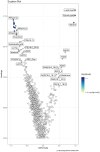Acute metabolite responses to swimming exercise of different intensities in highly trained male and female swimmers
- PMID: 40859644
- PMCID: PMC12381355
- DOI: 10.14814/phy2.70532
Acute metabolite responses to swimming exercise of different intensities in highly trained male and female swimmers
Abstract
We investigated metabolite responses to different swimming intensities in 16 highly trained swimmers (9 males, 7 females, aged 16-24 years). After determining critical swimming speed (CS) with a 12 × 25 m maximal effort test, participants completed three swimming trials at moderate (below CS), heavy (at CS), and severe (above CS) intensities on separate days. Capillary blood samples (1 mL) were collected before and after each trial for metabolite profiling via mass spectrometry. Orthogonal partial least squares analysis (OPLS-DA) revealed distinct metabolite changes between moderate and severe intensity trials [R2X (cum): 0.56; R2Y(cum): 0.95, pR2Y: 0.02, pQ2: 0.02]. Free fatty acids (FFAs) 18:0, 20:0, 20:4, and 22:4 showed higher log2 fold changes (log2FC) after moderate compared to heavy and severe trials (all p < 0.01). Plasma lactate, pyruvate, alanine, and HDL-4 cholesterol concentrations had greater log2FC after heavy and severe trials than moderate (all p < 0.01). Males tended to show lower log2FC in FFA than females in the severe trial, though this was not significant. These findings demonstrate that swimming intensity influences metabolite profiles, with reduced lipid metabolism and increased TCA cycle activity as intensity rises. A 1 mL capillary blood sample can effectively capture these metabolic shifts.
Keywords: biochemistry; energetics; metabolomics; phenotype.
© 2025 The Author(s). Physiological Reports published by Wiley Periodicals LLC on behalf of The Physiological Society and the American Physiological Society.
Figures





References
-
- Adams, K. J. , Pratt, B. , Bose, N. , Dubois, L. G. , St. John‐Williams, L. , Perrott, K. M. , Ky, K. , Kapahi, P. , Sharma, V. , & MacCoss, M. J. (2020). Skyline for small molecules: A unifying software package for quantitative metabolomics. Journal of Proteome Research, 19, 1447–1458. - PMC - PubMed
-
- Aird, T. P. , Farquharson, A. J. , Bermingham, K. M. , O'Sullivan, A. , Drew, J. E. , & Carson, B. P. (2022). Fasted sprint interval training results in some beneficial skeletal muscle metabolic, but similar metabolomic and performance adaptations compared with carbohydrate‐fed training in recreationally active male. International Journal of Sport Nutrition and Exercise Metabolism, 33, 73–83. - PubMed
-
- Amati, F. , Dubé, J. J. , Alvarez‐Carnero, E. , Edreira, M. M. , Chomentowski, P. , Coen, P. M. , Switzer, G. E. , Bickel, P. E. , Stefanovic‐Racic, M. , & Toledo, F. G. (2011). Skeletal muscle triglycerides, diacylglycerols, and ceramides in insulin resistance: Another paradox in endurance‐trained athletes? Diabetes, 60, 2588–2597. - PMC - PubMed
-
- Bates, D. , Mächler, M. , Bolker, B. , & Walker, S. (2014). Fitting linear mixed‐effects models using the lme4 package in R. Journal of Statistical Software, 67, 1–48.
-
- Beckner, M. E. , Thompson, L. , Radcliffe, P. N. , Cherian, R. , Wilson, M. , Barringer, N. , Margolis, L. M. , & Karl, J. P. (2023). Sex differences in body composition and serum metabolome responses to sustained, physical training suggest enhanced fat oxidation in women compared with men. Physiological Genomics, 55, 235–247. - PMC - PubMed
MeSH terms
Substances
Grants and funding
LinkOut - more resources
Full Text Sources
Research Materials

